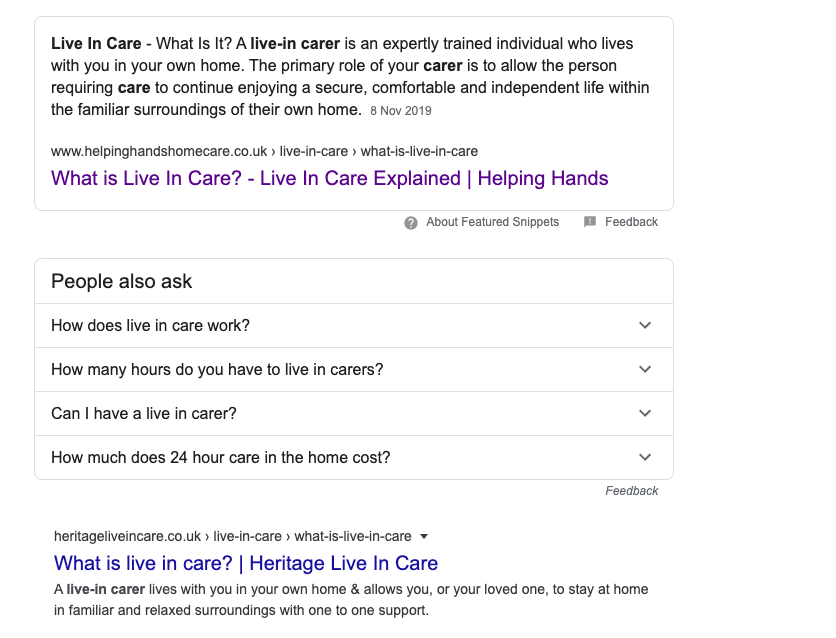On the tail of their Core Update, the 22nd January 2020 saw Google make some rather large changes regarding featured snippet duplication, and, being rolled out without much warning, these updates have been met with some confusion, to say the least. Here we’re looking at what featured snippets are, what the new changes realistically mean for your SEO marketing strategies, and how best to respond.
What are featured snippets and how have they changed?

Simply, they’re the textboxes that show on Google search results above the result listings, answering users’ questions quickly; they’re now officially part of the main organic search results. Previously, if a site held a featured snippet, they would still be listed on the first page of search results as well. However, with the new change, sites can only gain either a featured snippet or a first page ranking, i.e. it’s been “deduplicated” so only one or the other appears. The regular listing will still appear along with a featured snippet, but it will now be on the second page, usually position 11.
What does this change mean for SEO?
Naturally, this has shaken a few things up, proving yet again that staying ahead amidst constantly evolving SEO trends is a skill that can no longer be underestimated. As more and more updates have followed, and Google’s Danny Sullivan answers concerned questions, people have begun to wonder which ultimately has more benefits for a webpage – a first page ranking or a featured snippet?
The answer is: it depends. If you’ve used snippets before, the change might mean a disadvantage since your URL will now only appear once instead of twice. If you haven’t used snippets, however, your competitors will essentially now have half the URL presence they had before.
Since the changes occurred, many studies have been published analysing the difference having a featured snippet can make, and if it’s worth it. Marie Haynes asked her non-SEO friends (who aren’t considered to be ‘tech savvy’) if they click on the featured snippet or if they scroll down – interestingly, many of the respondents stated that they avoided featured snippets as they thought it was an Ad.
Some more details

Google is overall attempting to declutter and streamline front page results, and the change makes sense for users, even if it has caused some upheaval for marketers. The updates now mean that snippets are counted as “position 1” in the ten positions on the SERP, and if a URL is in the featured snippets, Google actively prevents it from appearing elsewhere in the core search results. But it is possible to have a joint featured snippet and a front-page listing, so long as they both direct to different URLs.
Similarly, featured snippet images are not deduplicated, provided they have a URL different from the snippet text. Carousels, People Ask, Answers, top stories, local listings, Bubbles and other refined featured snippets are not deduplicated. Neither are vertical search integrations (these are not featured snippets), direct answers or knowledge panels. The updates will have no impact on your Search Console performance.
It gets a little tricky, however: right side featured snippets originally were deduplicated (reported as a bug) but as of this article they are not, and will eventually be positioned at the top left.
How to respond to the featured snippet deduplication
SEO marketers are no strangers to rapid changes like this one – after all, Google makes hundreds of updates a year. Skilfully keeping a close eye on traffic and performance will allow a swift response and the appropriate action, which will naturally need to be unique for every company. Featured snippets are a coveted “zero-click” spot and reach your audience even without them seeing your URL. However, there will be times when users actually prefer to click on a URL, and where a main listing would perform better than a featured snippet.
There’s no easy answer to predict which strategy will work best; as with any other SEO update, trial and error is inevitable, and experimentation will show your SEO team which position benefits you most. It’s not a given that a featured snippet will be valuable your site, and it’s not a foregone conclusion that Google’s new changes will damage your SEO marketing efforts. If you do decide to opt out of featured snippets, try to reduce the size of your snippet to prevent Google from displaying it. If you lose a featured snippet, you should be able to revert to a normal first page listing on the SERP.
Not including a few bugs and erroneous results as the updates were initially rolled out, the changes look set for now, with more likely to come regarding moving snippets from the right sidebar and into the main column. However, there’s no need for panic – SEO is all about creatively adapting to new challenges, and there are always intelligent ways to work around any limitation.

